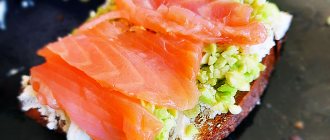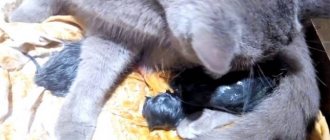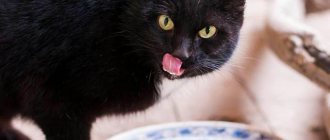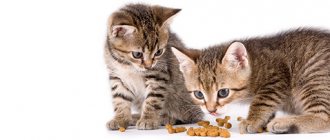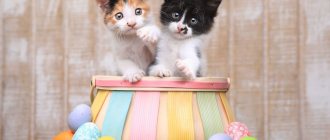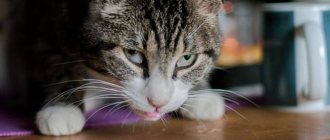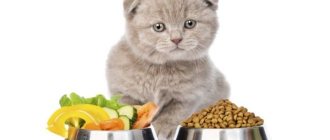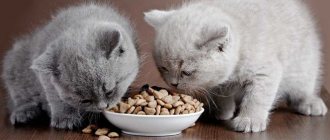Cheese is rich in microelements that have a beneficial effect on any organism, however, when including the product in the diet of pets, you must be extremely careful. Cheese can be both beneficial and harmful, so it is important to find out whether cats can have cheese, which varieties are best to use and in what quantity to give it to the animal.
Cheese in a cat's diet
Cats eat cheese with great pleasure, so the owner has to limit the animal and select the most healthy product.
You can give your cat cheese, but not too fatty, without dyes or preservatives in the composition. These restrictions immediately impose a ban on some types of cheese. Also, the body of some animals may not tolerate the product. Cats often experience indigestion due to the consumption of milk and its derivatives. This is due to age-related changes in the animal’s body.
When a kitten feeds on its mother's milk, its digestive system (intestinal enterocytes) produces lactase. It is necessary for the subsequent hydrolysis of lactose, the milk sugar contained in milk. Lactase breaks down lactose into 2 components - glucose and galactose, and in this form both components are absorbed by the small intestine. If there is little lactase, milk is not digested. Most often this is manifested by the occurrence of diarrhea in the animal.
According to calculations, for normal functioning of the intestines, a cat needs to consume no more than 2 g of lactose per 1 kg of body weight. If the milk consumption rate is significantly exceeded, fermentation processes are activated in the animal’s intestines, the cat begins to experience flatulence, pain in the abdomen, and the animal experiences frequent urges to go to the toilet.
Cheese is also a dairy product, but causes intolerance in rare cases. What is the reason for this, and is it possible to give cheese to a cat without negative consequences?
Products that have been lactic fermented contain less lactose than fresh milk. During the work of lactic acid bacteria and fungi, glucose is broken down into lactic acid and carbon dioxide, that is, there is less lactose per 100 g of product than before. This explains why cats can eat cheese.
Another fact in favor of cheeses is their slow movement throughout the body. Liquid milk quickly enters the large intestine, causing fermentation, and products such as cheese, cottage cheese or thick yogurt are partially digested in the small intestine, and when they enter the large intestine they no longer cause such a violently negative reaction as milk.
Lactose intolerance
Among cats, it is quite rare to find individuals who suffer from complete lactose intolerance. However, pathology in these animals cannot be completely excluded. Therefore, it is advisable for the owner to check whether the pet has such a pathological feature, and for this you can conduct a simple test:
- The animal should be given some dairy or fermented milk product, such as milk, kefir or cheese.
- During the first 24 hours, it is recommended to monitor the pet’s condition to see if it exhibits one or more symptoms of an allergic reaction: diarrhea (loose, watery stools), bloating, flatulence, nausea, vomiting, pain in the abdominal area. You should look into your pet's tray; it should not become more dirty than usual.
If there are no such signs, the cat behaves as usual and its condition has not changed, which means that the digestive system copes well with fermented milk products and has the enzymes necessary for processing lactose. In this case, the cat can be periodically pampered with sour milk, including a small slice of cheese.
Healthy cheese for cats
Cheese is rich in nutrients. Adyghe, for example, contains (per 100 g):
- proteins - 19 g;
- fat - 16 g;
- carbohydrates - 1.5 g.
The composition also contains vitamins and minerals: A, B2, PP, Ca, Na, P.
Most cheeses are made from pasteurized cow's milk, mesophilic starter culture, salt, and calcium chloride. The product is useful for the formation of the skeletal system; its regular consumption makes the coat shiny and the skin healthy.
Cheeses promote the release of digestive enzymes, stimulate digestion, and normalize appetite. However, there are pitfalls that are worth being aware of.
The disadvantage of cheese is its high fat content, so for animals prone to excessive weight gain, even a small piece is harmful.
How to keep cheese safe
It is impossible to make cheese safe without decomposing it into a tasteless paste. Cooking or freezing is aimed at destroying bacteria, which do not pose a danger in these products. Mold is present, but it causes problems in the form of allergic reactions in only too few animals. Much more often, lactose is the cause of problems.
Cheese is dangerous due to a large amount of fat, spices and salt, which are not destroyed when cooled. The damaging effect of freezing is based on the expansion of water, which ruptures microorganisms as it turns into ice. However, there is too little water in cheeses, and most products do not contain any bacteria.
Prolonged cooking can decompose fats, but this will only happen along with the destruction of all vitamins and proteins, which reduces the nutritional value of the product. As a result of prolonged cooking in cheese, most of its elements are destroyed, which is why it loses its shape and taste.
Cheese is given exclusively in its raw form; it cannot be cooked. This product is also not prepared in any way. At one time, you can give your pet a small cube no larger than a centimeter in size. Cheese is used as a treat, that is, it is added to the animal’s diet no more than once a week. You can feed it to adult pets and kittens older than six months. Before giving it for the first time, you need to make sure that the cat is not allergic to lactose (give her a little milk).
Peculiarities of cheese consumption by castrated animals
The castration procedure changes the lifestyle of cats and female cats. They become more docile, passive, and at the same time, owners note an increase in the appetite of their pets. But with increased gluttony, the digestive system works worse and worse. This leads to disruptions in the functioning of internal organs, in particular to the development of urolithiasis and obesity.
A castrated cat can have cheese, but only in controlled quantities. The varieties should be the least caloric and low-fat.
Cheese-related products
Having heard the term, a person imagines a yellow dense piece with holes. But cheese is called different products. In English the word additionally means:
Cats like all these dishes. Breed does not affect preference. Elite pets and yard dwellers show interest in cheeses. Animals can literally snatch a milk-coated sandwich from a person. The decision to share with your pet depends on the composition of the product.
Potentially Hazardous Components
Cats and people perceive biological substances differently. Onions (tuber and stems) and garlic are dangerous foods that can cause the breakdown of red blood cells. Not found in regular cheeses, they are potential additives for brushes, processed foods, and pet-attracting flavorings.
Other potentially hazardous ingredients include:
- Mold – you should not give elite cheese to cats. Microorganisms can disrupt the bacterial balance of the intestines. A product that has become more expensive in the refrigerator should not be eaten by the animal or its owner.
Dyes. Stores offer colorful cheeses, colored by natural additives: tomatoes, lavender, herbs. Natural and synthetic pigments are potentially dangerous for cats. Natural dyes will provide a rich shade due to their high concentration. Spices and nightshades (tomatoes) are potential toxins for cats. Synthetic pigments tend to accumulate in the body, affecting the functions of internal organs.
Flavorings, taste enhancers. They are addictive, can cause allergies and other unpleasant consequences.
Homemade dairy products pose additional risks. Raw cottage cheese (cheese cheese) may contain pathogens, manufacturer. Having caused indigestion in a person, it can cause serious poisoning and damage to internal organs in a pet.
Fat content of cheeses, varieties
The table below shows the most popular types of cheese. These data will help determine whether your cat can be given cheese:
| Cheese, name | Fat percentage | Should I give it to my cat? |
| Adyghe | 16% | Yes, it is healthy, contains many essential microelements |
| Roquefort | 45% | After testing. Possible allergy to mold |
| Cheddar | 50% | Yes |
| Dutch | 45% | No, it contains a lot of salts and spices |
| Swiss | 50% | Yes, limited. Contains a lot of salts |
| Blue | 30% | After testing. Possible allergy to mold |
| Ricotta | 25% | Yes, useful |
| Fused | 50% | No, it contains a lot of salts and a lot of spices |
When choosing cheese for your pet, you should follow the following rules:
- The less salt the better. It is necessary to exclude cheeses containing large amounts of salt from the animal’s diet.
- Less fat. The maximum permissible fat content limit is 50%. The animal’s digestive system cannot cope with fattier foods.
- Less spices. Flavorings and flavor enhancers are often strong carcinogens, allergens, and when constantly introduced into the cat's body, they cause various diseases.
- Only natural. If the cheese packaging lists powdered milk, soy, vegetable oil, flavorings and flavorings among the first ingredients, then there is nothing useful for humans or animals in this product.
There are many varieties of cheeses that differ radically in appearance and taste characteristics:
- Smoked. When making smoked cheeses, the method used is not natural smoking, but with the use of chemicals that accelerate the appearance of a specific smoked smell and golden color. Such components contain many carcinogenic inclusions, so smoked braided cheese, for example, should not be offered to cats.
- Fused. Such cheese curds are the result of pasteurization of several basic products: cheeses, butter, milk, melting salts. The result is a product with high fat content and high salt content, and to add a piquant taste, seasonings with aromas of mushrooms, smoked meats and other unhealthy components are added to processed cheeses. There is no need to give your cat processed cheese.
- With mold. Such cheeses are sold with a moldy crust of bluish, white, and red colors. Appearance depends on the specifics of production. Blue cheeses are safe for animals if the pet does not have a food allergy. If, when eating a small piece of Roquefort, Camembert, cheddar or other cheese belonging to this group, the pet develops itching, red eyes or other specific reactions occur, the supply of the exotic product should be stopped immediately. Cats can only be given blue cheese if they are not allergic.
Cheeses also differ in the method of production. The most preferable for pets are fermented milk, whey, mold.
Whey is made from whey, that is, it is the result of secondary production. They are low in fat. This category includes Adyghe cheese, rich in nutrients and safe for animals.
Fermented milk cheeses are made from skim milk, and to vary the percentage of fat content, butter and sour cream can be added to them. When purchasing such a product for your pet, you should pay attention to the fat content and the presence of additives.
Mold cheeses are made from goat, cow, and sheep milk. They are useful and well tolerated by pets in the absence of allergies to mold fungi.
The rating of cheeses unsuitable for cats includes rennet and smoked ones. Both contain a lot of salt, preservatives, carcinogens in the form of dyes, flavor enhancers and other food additives.
You can give your cat cheese every day, but the piece should be small - 5-10 g. Pets should receive cheese as a treat, and not as a main meal, and then the pet will be happy and healthy.
Why cheese can be dangerous
Cheeses can be dangerous for many reasons. The greatest harm comes from salt, fat and spices:
- Cheeses contain a lot of salt - 1.5-2.5% of the total weight, sometimes up to 7%. Cats are predisposed to urolithiasis, which is caused by narrow and tortuous urinary tracts. They must exclude salt from their diet, and cheese contains it in increased quantities.
- The amount of fat reaches 60-70% . Such an unnaturally large amount of fatty acids does not occur in nature, so the liver and pancreas of cats are not adapted to digest such products. Why cheeses can cause digestive upset.
- Spices and various additives are added to many cheeses . At best, they will be of plant origin (cumin and others). But in most situations these include chemical antioxidants, thickeners, preservatives, dyes, emulsifiers and other substances. All these compounds can cause an allergic reaction.
general information
Cheese is a product made from milk with the addition of bacteria, coagulating enzymes and molds.
Thanks to a special production technology, cheese products are better absorbed by the cat’s body than milk (read more about whether cats can have milk).
In addition, cheese is valued for its quality composition:
- Up to 25% animal protein.
- Up to 60% – polyunsaturated fatty acids.
- 3-3.5% are useful microelements, including calcium and phosphorus.
- A whole complex of vitamin components: retinol, ascorbic acid, thiamine, riboflavin, pantothenic acid, cyanocobalamin, calciferol, tocopherol, nicotinic acid.
The composition of cheese is similar to that of the original product - milk; it contains valuable components in the same proportions. Based on this, cheese is allowed to be included in the diet of cats, like other fermented milk products: kefir, yogurt, cottage cheese, yogurt. However, the high fat content of cheese products - from 30 to 55% - does not allow them to be given to pets as daily food. Cheese is given to them exclusively as a treat.
This is interesting: Why can't cats have sweets?
Lactose allergy test
You cannot feed a cat, especially a kitten, cheese at its first request. Before consuming a certain (low-fat) type of product for the first time, you need to find out or remember how the animal’s body reacts to lactose. This substance is included in any dairy product. If a cat develops indigestion - diarrhea - after eating this product, it is likely that this process will occur after feeding it cheese.
© shutterstock
Some animals cannot enjoy milk without “consequences,” but tolerate fermented milk products well. In this case, you can try using cheese to feed them. It should be introduced into the diet carefully, starting with a very small piece; you cannot immediately offer a large portion.
Cheese components can act as an allergen on the cat's body. Frequent manifestations of such reactions are problems with the animal’s skin; its hair may fall out significantly. If such signs appear, your pet’s diet should be adjusted.
The health benefits of cheese for kittens
Cheese is a fermented milk product, rich in vitamins and minerals, well absorbed by the digestive system, and beneficial for the rapidly growing kitten’s body. The fermented milk product contains complete protein, which is necessary for the development of muscle mass of a “miniature predator”. Milk fat not only serves as a source of energy for active kittens, but also preserves fat-soluble vitamins and also improves the condition of the coat.
Calcium, which is rich in any type of cheese, is responsible for the formation of strong bones and a mobile spine, healthy teeth and sharp claws. An important macronutrient is absorbed worse from cheese than from cottage cheese. Should kittens be given cheese for complementary feeding or can they limit themselves to cottage cheese? Compared to cottage cheese or chicken eggs, cheese is more balanced in minerals and vitamins, which compensates for the reduced absorption of calcium.
In the first weeks of life, the immunity of furry babies is supported by the protective properties of colostrum. When switching to adult food, you should take care of the animal’s intake of vitamins and minerals. Regular feeding of cheese will provide kittens with vitamins C, A, E and choline, which will support the development of their own immunity. Phosphorus, potassium and other minerals will ensure the normal development of the organs and nervous system of your pet.
Raw meat
You can feed your cat raw meat, but you need to keep in mind the pros and cons of such food.
There is no doubt that in the wild animals eat raw meat and feeding a cat such meat is more natural. It is worth noting that during heat treatment, meat loses a significant part of its nutrients, aroma and juiciness. However, there are also disadvantages to feeding your cat raw meat. The main disadvantage is dangerous infections that can cause significant harm to the health of the animal. A helminthic infestation is also possible when feeding a cat raw meat.
If you are confident in the safety of raw meat that you want to pamper your cat with, then you should give the animal only lean veal, beef, lamb and poultry. Fatty meat and pork should not be given.

